- Home
- Jared Diamond
Why Is Sex Fun? Page 2
Why Is Sex Fun? Read online
Page 2
·····
Thus, even a non-mammalo-centric view reinforces our dog’s interpretation: we are the ones who are bizarre. We marvel at what seems to us the weird behavior of peacocks and big-bang marsupial mice, but those species actually fall securely within the range of animal variation, and in fact we are the weirdest of them all. Species-ist zoologists theorize about why hammer-headed fruit bats evolved their lek mating system, yet the mating system that cries out for explanation is our own. Why did we evolve to be so different?
This question becomes even more acute when we compare ourselves with our closest relatives among the world’s mammal species, the great apes (as distinguished from the gibbons or little apes). Closest of all are Africa’s chimpanzee and bonobo, from which we differ in only about 1.6 percent of our nuclear genetic material (DNA). Nearly as close are the gorilla (2.3 percent genetic difference from us) and the orangutan of Southeast Asia (3.6 percent different). Our ancestors diverged “only” about seven million years ago from the ancestors of chimpanzees and bonobos, nine million years ago from the ancestors of gorillas, and fourteen million years ago from the ancestors of orangutans.
That sounds like an enormous amount of time in comparison to an individual human lifetime, but it’s a mere eye-blink on the evolutionary time scale. Life has existed on Earth for more than three billion years, and hard shelled, complex large animals exploded in diversity more than half a billion years ago. Within that relatively short period during which our ancestors and the ancestors of our great ape relatives have been evolving separately, we have diverged in only a few significant respects and to a modest degree, even though some of those modest differences—especially our upright posture and larger brains—have had enormous consequences for our behavioral differences.
Along with posture and brain size, sexuality completes the trinity of the decisive respects in which the ancestors of humans and great apes diverged. Orangutans are often solitary, males and females associate just to copulate, and males provide no paternal care; a gorilla male gathers a harem of a few females, with each of which he has sex at intervals of several years (after the female weans her most recent offspring and resumes menstrual cycling and before she becomes pregnant again); and chimpanzees and bonobos live in troops with no lasting male-female pair bonds or specific father-offspring bonds. It is clear how our large brain and upright posture played a decisive role in what is termed our humanity—in the fact that we now use language, read books, watch TV, buy or grow most of our food, occupy all continents and oceans, keep members of our own and other species in cages, and are exterminating most other animal and plant species, while the great apes still speechlessly gather wild fruit in the jungle, occupy small ranges in the Old World tropics, cage no animal, and threaten the existence of no other species. What role did our weird sexuality play in our achieving these hallmarks of humanity?
Could our sexual distinctiveness be related to our other distinctions from the great apes? In addition to (and probably ultimately as a product of) our upright posture and large brains, those distinctions include our relative hairlessness, dependence on tools, command of fire, and development of language, art, and writing. If any of these distinctions predisposed us toward evolving our sexual distinctions, the links are certainly unclear. For example, it is not obvious why our loss of body hair should have made recreational sex more appealing, nor why our command of fire should have favored menopause. Instead, I shall argue the reverse: recreational sex and menopause were as important for our development of fire, language, art, and writing as were our upright posture and large brains.
·····
The key to understanding human sexuality is to recognize that it is a problem in evolutionary biology. When Darwin recognized the phenomenon of biological evolution in his great book On the Origin of Species, most of his evidence was drawn from anatomy. He inferred that most plant and animal structures evolve—that is, they tend to change from generation to generation. He also inferred that the major force behind evolutionary change is natural selection. By that term, Darwin meant that plants and animals vary in their anatomical adaptations, that certain adaptations enable individuals bearing them to survive and reproduce more successfully than other individuals, and that those particular adaptations therefore increase in frequency in a population from generation to generation. Later biologists showed that Darwin’s reasoning about anatomy also applies to physiology and biochemistry: an animal’s or plant’s physiological and biochemical characteristics also adapt it to certain lifestyles and evolve in response to environmental conditions.
More recently, evolutionary biologists have shown that animal social systems also evolve and adapt. Even among closely related animal species, some are solitary, others live in small groups, and still others live in large groups. But social behavior has consequences for survival and reproduction. Depending, for example, on whether a species’ food supply is clumped or spread out, and on whether a species faces high risk of attack by predators, either solitary living or group living may be better for promoting survival and reproduction.
Similar considerations apply to sexuality. Some sexual characteristics may be more advantageous for survival and reproduction than others, depending on each species’ food supply, exposure to predators, and other biological characteristics. At this point I shall mention just one example, a behavior that at first seems diametrically opposed to evolutionary logic: sexual cannibalism. The male of some species of spiders and mantises is routinely eaten by his mate just after or even while he is copulating with her. This cannibalism clearly involves the male’s consent, because the male of these species approaches the female, makes no attempt to escape, and may even bend his head and thorax toward the female’s mouth so that she may munch her way through most of his body while his abdomen remains to complete the job of injecting sperm into her.
If one thinks of natural selection as the maximization of survival, such cannibalistic suicide makes no sense. Actually, natural selection maximizes the transmission of genes, and survival is in most cases just one strategy that provides repeated opportunities to transmit genes. Suppose that opportunities to transmit genes arise unpredictably and infrequently, and that the number of offspring produced by such opportunities increases with the female’s nutritional condition. That’s the case for some species of spiders and mantises living at low population densities. A male is lucky to encounter a female at all, and such luck is unlikely to strike twice. The male’s best strategy is to produce as many offspring bearing his genes as possible out of his lucky find. The larger a female’s nutritional reserves, the more calories and protein she has available to transform into eggs. If the male departed after mating, he would probably not find another female and his continued survival would thus be useless. Instead, by encouraging the female to eat him, he enables her to produce more eggs bearing his genes. In addition, a female spider whose mouth is distracted by munching a male’s body allows copulation with the male’s genitalia to proceed for a longer time, resulting in more sperm transferred and more eggs fertilized. The male spider’s evolutionary logic is impeccable and seems bizarre to us only because other aspects of human biology make sexual cannibalism disadvantageous. Most men have more than one lifetime opportunity to copulate; even well-nourished women usually give birth to only a single baby at a time, or at most twins; and a woman could not consume enough of a man’s body at one sitting to improve significantly the nutritional basis for her pregnancy.
This example illustrates the dependence of evolved sexual strategies on both ecological parameters and the parameters of a species’ biology, both of which vary among species. Sexual cannibalism in spiders and mantises is favored by the ecological variables of low population densities and low encounter rates, and by the biological variables of a female’s capacity to digest relatively large meals and to increase her egg output considerably when well nourished. Ecological parameters can change overnight if an individual colonizes a new type of habitat, but
the colonizing individual carries with it a baggage of inherited biological attributes that can change only slowly, through natural selection. Hence it is not enough to consider a species’ habitat and lifestyle, design on paper a set of sexual characteristics that would be well matched to that habitat and lifestyle, and then be surprised that those supposedly optimal sexual characteristics do not evolve. Instead, sexual evolution is severely constrained by inherited commitments and prior evolutionary history.
For example, in most fish species a female lays eggs and a male fertilizes those eggs outside the female’s body, but in all placental mammal species and marsupials a female gives birth to live young rather than to eggs, and all mammal species practice internal fertilization (male sperm injected into the female’s body). Live birth and internal fertilization involve so many biological adaptations and so many genes that all placental mammals and marsupials have been firmly committed to those attributes for tens of millions of years. As we shall see, these inherited commitments help explain why there is no mammal species in which parental care is provided solely by the male, even in habitats where mammals live alongside fish and frog species whose males are the sole providers of parental care.
We can thus redefine the problem posed by our strange sexuality. Within the last seven million years, our sexual anatomy diverged somewhat, our sexual physiology further, and our sexual behavior even more, from those of our closest relatives, the chimpanzees. Those divergences must reflect a divergence between humans and chimpanzees in environment and lifestyle. But those divergences were also limited by inherited constraints. What were the lifestyle changes and inherited constraints that molded the evolution of our weird sexuality?
CHAPTER 2
THE BATTLE OF THE SEXES
In the preceding chapter we saw that our effort to understand human sexuality must begin by our distancing ourselves from our warped human perspective. We’re exceptional animals in that our fathers and mothers often remain together after copulating and are both involved in rearing the resulting child. No one could claim that men’s and women’s parental contributions are equal: they tend to be grossly unequal in most marriages and societies. But most fathers make some contribution to their children, even if it’s just food or defense or land rights. We take such contributions so much for granted that they’re written into law: divorced fathers owe child support, and even an unwed mother can sue a man for child support if genetic testing proves that he is her child’s father.
But that’s our warped human perspective. Alas for sexual equality, we’re aberrations in the animal world, and especially among mammals. If orangutans, giraffes, and most other mammal species could express their opinion, they would declare our child support laws absurd. Most male mammals have no involvement with either their offspring or their offspring’s mother after inseminating her; they are too busy seeking other females to inseminate. Male animals in general, not just male mammals, provide much less parental care (if any) than do females.
Yet there are quite a few exceptions to this chauvinist pattern. In some bird species, such as phalaropes and Spotted Sandpipers, it’s the male that does the work of incubating the eggs and rearing the chicks, while the female goes in search of another male to inseminate her again and to rear her next clutch. Males of some fish species (like seahorses and sticklebacks) and some amphibian males (like midwife toads) care for the eggs in a nest or in their mouth, pouch, or back. How can we explain simultaneously this general pattern of female parental care and also its numerous exceptions?
The answer comes from the realization that genes for behavior, as well as for malaria resistance and teeth, are subject to natural selection. A behavior pattern that helps individuals of one animal species pass on their genes won’t necessarily be helpful in another species. In particular, a male and female that have just copulated to produce a fertilized egg face a “choice” of subsequent behaviors. Should that male and female both leave the egg to fend for itself and set to work on producing another fertilized egg, copulating either with the same partner or with a different partner? On the one hand, a time-out from sex for the purpose of parental care might improve the chances of the first egg surviving. If so, that choice leads to further choices: both the mother and the father could choose to provide the parental care, or just the mother could choose to do so, or just the father could. On the other hand, if the egg has a one-in-ten chance of surviving even with no parental care, and if the time you’d devote to tending it would alternatively let you produce 1,000 more fertilized eggs, you’d be best off leaving that first egg to fend for itself and going on to produce more fertilized eggs.
I’ve referred to these alternatives as “choices.” That word may seem to suggest that animals operate like human decision-makers, consciously evaluating alternatives and finally choosing the particular alternative that seems most likely to advance the animal’s self-interest. Of course, that’s not what happens. Many of the so-called choices actually are programmed into an animal’s anatomy and physiology. For example, female kangaroos have “chosen” to have a pouch that can accommodate their young, but male kangaroos have not. Most or all of the remaining choices are ones that would be anatomically possible for either sex, but animals have programmed instincts that lead them to provide (or not to provide) parental care, and this instinctive “choice” of behavior can differ between sexes of the same species. For example, among parent birds, both male and female albatrosses, male but not female ostriches, females but not males of most hummingbird species, and no brush turkeys of either sex are instinctively programmed to bring food to their chicks, although both sexes of all of these species are physically and anatomically perfectly capable of doing so.
The anatomy, physiology, and instincts underlying parental care are all programmed genetically by natural selection. Collectively, they constitute part of what biologists term a reproductive strategy. That is, genetic mutations or recombinations in a parent bird could strengthen or weaken the instinct to bring food to the chicks and could do so differently in the two sexes of the same species. Those instincts are likely to have a big effect on the number of chicks that survive to carry on the parent’s genes. It’s obvious that a chick to which a parent brings food is more likely to survive, but we shall also see that a parent that forgoes bringing food to its chicks thereby gains other increased chances to pass on its genes. Hence the net effect of a gene that causes a parent bird instinctively to bring food to its chicks could be either to increase or to decrease the number of chicks carrying on the parent’s genes, depending on ecological and biological factors that we shall discuss.
Genes that specify the particular anatomical structures or instincts most likely to ensure the survival of offspring bearing the genes will tend to increase in frequency. This statement can be rephrased: anatomical structures and instincts that promote survival and reproductive success tend to become established (genetically programmed) by natural selection. But the need to make wordy statements such as these arises very often in any discussion of evolutionary biology. Hence biologists routinely resort to anthropomorphic language to condense such statements—for example, they say that an animal “chooses” to do something or pursues a certain strategy. This shorthand vocabulary should not be misconstrued as implying that animals make conscious calculations.
·····
For a long time, evolutionary biologists thought of natural selection as somehow promoting “the good of the species.” In fact, natural selection operates initially on individual animals and plants. Natural selection is not just a struggle between species (entire populations), nor is it just a struggle between individuals of different species, nor just between conspecific individuals of the same age and sex. Natural selection can also be a struggle between parents and their offspring or a struggle between mates, because the self-interests of parents and their offspring, or of father and mother, may not coincide. What makes individuals of one age and sex successful at transmitting their genes may not increase t
he success of other classes of individuals.
In particular, while natural selection favors both males and females that leave many offspring, the best strategy for doing so may be different for fathers and mothers. That generates a built-in conflict between the parents, a conclusion that all too many humans don’t need scientists to reveal to them. We make jokes about the battle of the sexes, but the battle is neither a joke nor an aberrant accident of how individual father or mothers behave on particular occasions. It is indeed perfectly true that behavior that is in a male’s genetic interests may not necessarily be in the interests of his female co-parent, and vice versa. That cruel fact is one of the fundamental causes of human misery.
Consider again the case of the male and female that have just copulated to produce a fertilized egg and now face the “choice” of what to do next. If the egg has some chance of surviving unassisted, and if both the mother and the father could produce many more fertilized eggs in the time that they would devote to tending that first fertilized egg, then the interests of the mother and father coincide in deserting the egg. But now suppose that the newly fertilized, laid, or hatched egg or newborn offspring has absolutely zero chance of surviving unless it is cared for by one parent. Then there is indeed a conflict of interest. Should one parent succeed in foisting the obligation of parental care onto the other parent and then going off in search of a new sex partner, then the foister will have advanced her or his genetic interests at the expense of the abandoned parent. The foister will really promote his or her selfish evolutionary goals by deserting his or her mate and offspring.

 Why Is Sex Fun?: The Evolution of Human Sexuality
Why Is Sex Fun?: The Evolution of Human Sexuality Guns, Germs, and Steel: The Fates of Human Societies
Guns, Germs, and Steel: The Fates of Human Societies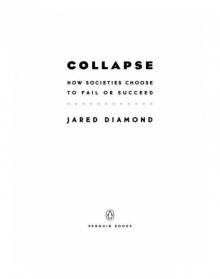 Collapse: How Societies Choose to Fail or Succeed
Collapse: How Societies Choose to Fail or Succeed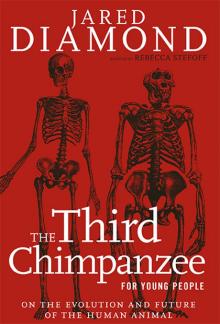 The Third Chimpanzee: The Evolution and Future of the Human Animal
The Third Chimpanzee: The Evolution and Future of the Human Animal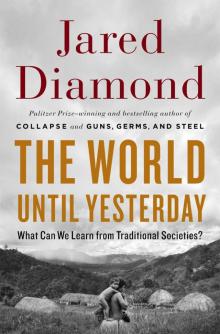 The World Until Yesterday: What Can We Learn From Traditional Societies?
The World Until Yesterday: What Can We Learn From Traditional Societies?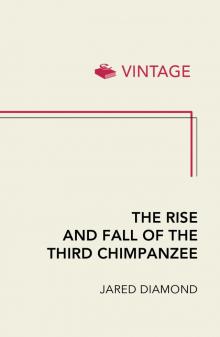 The Rise and Fall of the Third Chimpanzee
The Rise and Fall of the Third Chimpanzee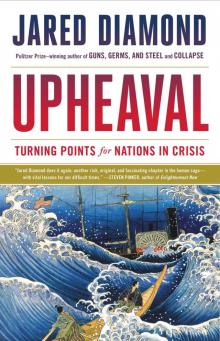 Upheaval: Turning Points for Nations in Crisis
Upheaval: Turning Points for Nations in Crisis Guns, Germs, and Steel
Guns, Germs, and Steel The Third Chimpanzee for Young People
The Third Chimpanzee for Young People Why Is Sex Fun?
Why Is Sex Fun?